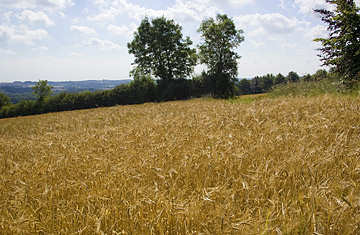
A ripening barley field in Bourton on the Water in Gloucestershire, Britain
Farms vs. forests — that's the usual dynamic in tropical countries, where the growth of agriculture often comes at the expense of trees. In nations like Brazil and Indonesia — where deforestation is behind the vast majority of carbon emissions — rain forests are not just cut down for logging but also burned to make room for new farms and pastureland. As more people need more food — and biofuels as well — there's a risk that we could see many of our remaining virgin rain forests wiped out completely.
But a major new study indicates that farms and forests may not be as incompatible as we often assume. Using detailed satellite imagery, scientists from the World Agroforestry Centre (WAC) found that on almost half of all farmed landscapes around the world, landowners are either sparing some existing trees or planting new ones, leading to what the study calls "significant" tree cover. In fact, on more than 1 billion hectares (2.5 billion acres) of farmland, which is twice the size of the Amazon, tree cover exceeds 10%. That's a huge increase from previous estimates, which were as low as 50,000 hectares.
This unexpected shift in the trend of clear-cutting and -burning is a result of what's known as agroforestry, an increasingly popular practice, which according to Dennis Garrity, the Nairobi-based director-general of the WAC, could be a "real compensation for deforestation." Farmers are planting trees on their property not because they want to suck up carbon dioxide — at least, not yet. Rather, trees can add value to agriculture. Fruit and nut trees provide additional income or even subsistence food, especially in times of drought, since trees are generally hardier than crops. Trees also provide salable commodities like coffee, rubber, gum and timber. And even if a stand of trees doesn't produce anything worth selling or eating, it still creates shade, protects against erosion and preserves water quality.
Trees are present more among farmlands in the dense tropical areas of Southeast Asia and Central America, along with much of South America. The proportion is lower in sub-Saharan Africa — although Nobel Peace laureate Wangari Maathai's Green Belt Movement has helped plant more than 30 million trees for Africa's poor. The difference seems to come down mostly to support for tree-planting by governments or NGOs like Maathai's. In places where agroforestry is encouraged this way, trees are far likelier to bloom than in places where farmers are given no such guidance.
And that's where the international community can help. Planting new trees on farmland could provide a needed carbon sink, especially if tropical deforestation continues. Right now agroforestry isn't a major part of international climate-change policy, but delegates at the U.N. global-warming summit in Copenhagen that will convene in December could change all that. By putting a greater carbon value on trees planted on farmland through a cap-and-trade program that would give companies a carbon credit for growing and maintaining trees, we could encourage the growth of agroforestry. It's not a perfect compensation for continued deforestation — whole, virgin rain forests have an enormous ecological value that can't be replicated by agroforestry — but it's a realistic fallback. "This is a win-win investment opportunity for the world," says Garrity. It's also a rare bit of green good news.
